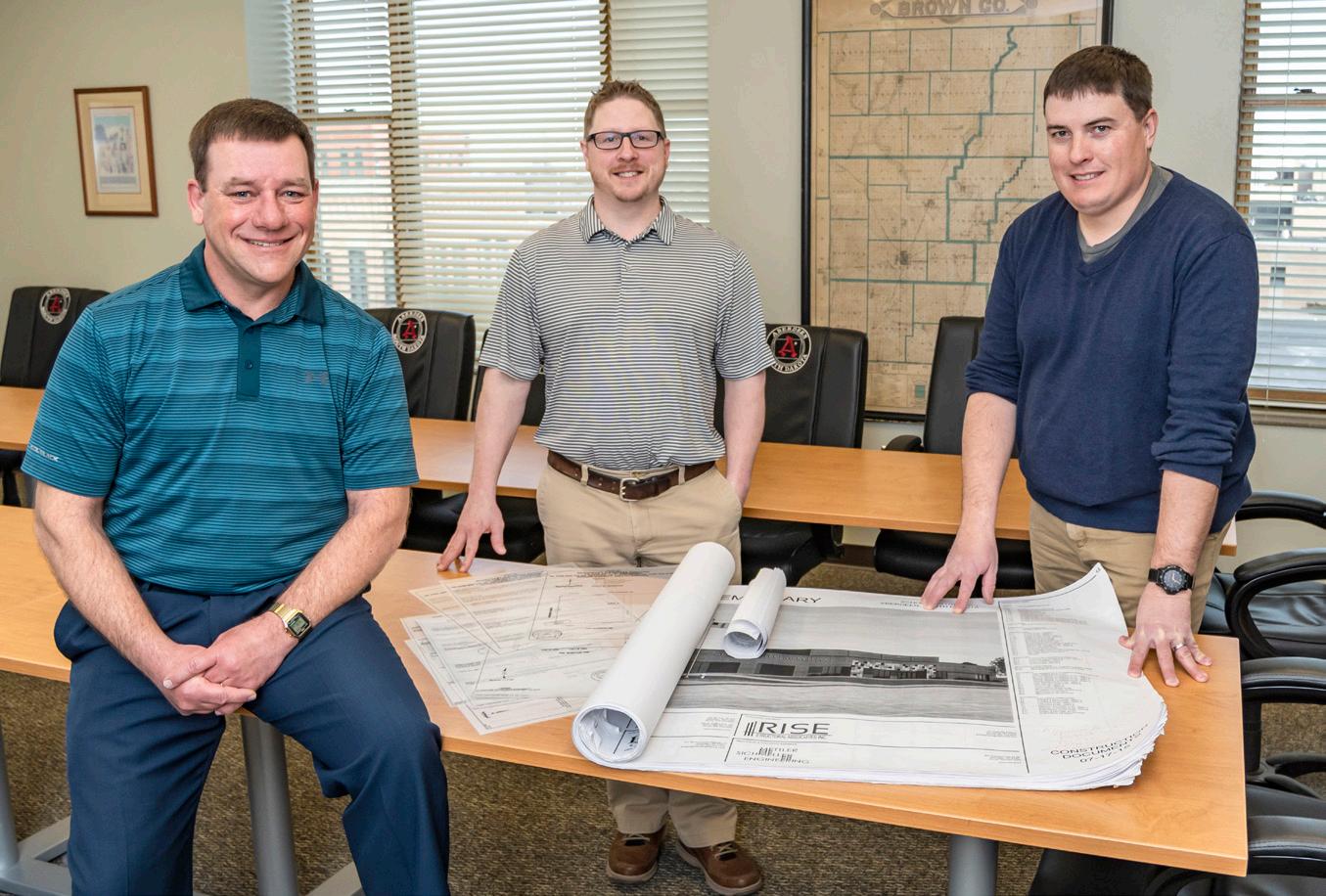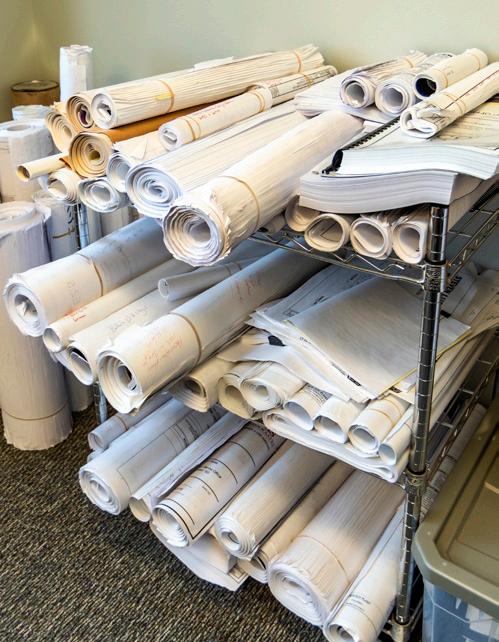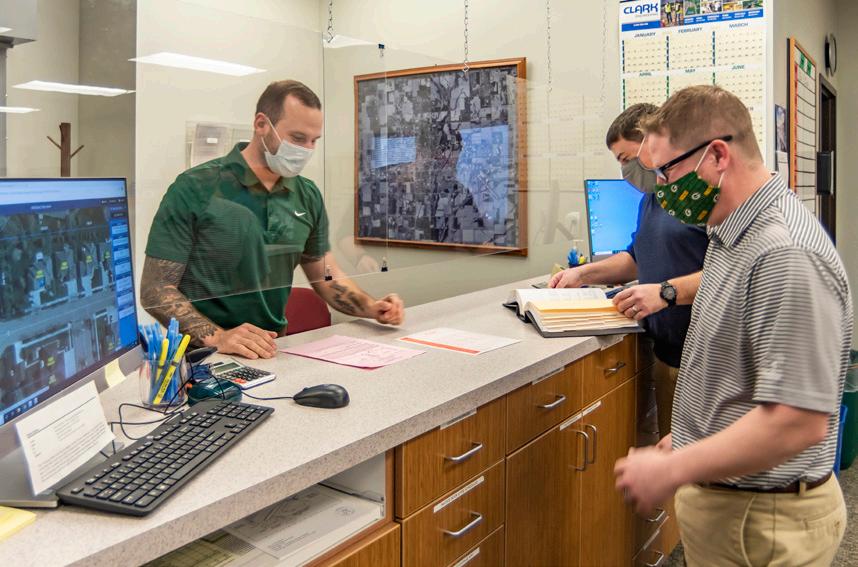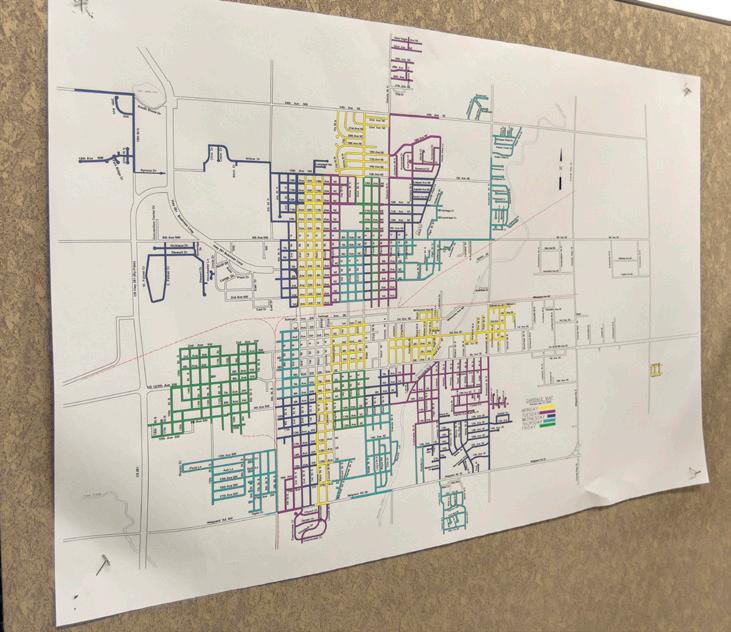
15 minute read
NO, WE DON’T JUST TELL PEOPLE NO
Pictured L to R are Brett Bill, planning and zoning director/ building official, Eric Miller, planner, and Ken Hubbart, planner.
When I asked Brett Bill if his job was a little like herding cats, Aberdeen’s city planner wouldn’t go there. Cats have a reputation for being self-centered and interested only in their own needs and desires. Clearly, Brett didn’t think the comparison was fair to Aberdeen citizens who can go out of their way to help their friends and neighbors. No matter what, however, herding cats was how it felt to try to get a handle on this story about an entity with such broad reach and impact on Aberdeen. Inevitably, some of the cats couldn’t fit in the space allowed, so this is a big but still limited picture of the department.
Advertisement
Big picture is still apt. Brett said the Planning, Zoning and Code Enforcement Department “covers all aspects of things that happen in people’s daily lives—for example, the street network, the layout of where homes are located, setbacks from neighbors’ homes, where their favorite stores are located, where the salon or barbershop is, and on and on.” In other words, Planning impacts where we live, work, travel, and play. Sometimes, it has to get involved at the picture’s pixel-level when it implements and enforces plans and ordinances passed due to public input and city council adoption. “People don’t like to be told what to do with their property,” he said. “We deal with the perception that we’re stepping on their rights as property owners.” In reality, “We’re trying to protect people from their neighbors and their neighbors from them,” he said. And maybe protecting people from themselves—although even that can be too much for some.
Aberdeen’s city planner and department director for 23 years, Brett ticks off Planning’s basic duties, “We direct and assist the city’s growth through many avenues, including through the comprehensive plan and the zoning ordinance. We conduct building inspections and code enforcement in town, and this is also the city health office.” When he first came to the department in the 1990s, there were five people on staff. Now there are ten, including two other planners, who most often work directly with people at the window, which is where most of the work gets done. He noted, “The big thing here is customer service. We try to help the public and give them guidance, even if it’s not always seen that way. Our goal is to grow and develop the city, not hinder it.”
Brett is frustrated, however, that his department seems to have a reputation for denying anything residents want to do with their property or business. “Our job isn’t to tell people ‘no.’ It’s to help them do it right. We want people to be successful because then the city is successful.”
PLANNING’S PLAN Earlier, Brett mentioned the comprehensive plan. According to the one adopted in 2019, a comprehensive plan “presents a long-range vision for the future and the steps to accomplish
The city’s Planning, Zoning, and Code Enforcement
Department provides resources to residents and follows comprehensive guides to help grow and develop the city.


that vision including a policy framework from which the zoning ordinance, site and subdivision regulations, capital improvements plan, and annual budget are guided.” The current plan is the third Brett has been involved with in Aberdeen. He wrote the first of those plans when he started with the department. The 125-page 2019 plan has a 2045 target date. It establishes goals and an implementation plan for broad aspects of city life, including population, land use, housing, business, tourism, recreation, and transportation, among others. It was developed by a steering committee composed of city staff and officials and citizens, informed by input from the public, and ultimately, adopted by the city council.
A few examples of the areas where Planning is involved will help demonstrate its work and impact. It’s important to remember that what they do is based on the comprehensive plan and related ordinances generated with public input and participation and approved and enacted by the community’s elected representatives. They don’t just come from Brett’s whim.
As suggested earlier, the department’s work impacts where Aberdeen lives, works, travels, and plays. They are less directly involved in the last two. The comprehensive plan addresses Aberdeen roads and identifies probable future transportation needs. It also reviews recreation in the city and proposes park spaces for anticipated areas of future growth. In both of these categories, however, other departments carry out the plans. The department also has some interest in where we worship, as the zoning ordinance identifies areas that would work better for that purpose. But houses of worship have turned up in other areas without city opposition.
ZONING Zoning is a key aspect of the department’s work. According to the department’s website, the purpose of zoning is to “establish permitted uses of land, control the intensity of its development, and to minimize conflicting land uses from being adjacent to one another.” It’s a complex process, perhaps best indicated by the fact that as recently as the 1950s, Aberdeen had just three zoning districts. Now, it has more than 20, mainly due to the need to create transitional areas between different land uses. The goal is to put some distance between residential areas and the sounds and smells of industrial zones and the traffic of commercial areas. Brett said, “We try to keep the zoning ordinance basic to keep it clear and understandable for the public. The zoning for some cities reads like it’s in Greek.”
LIVE Not surprisingly, where people live—in the senses of both the general areas in the city and more specifically the homes themselves—is a major focus of the department. From a macro view, zoning defines residential areas, and the comprehensive plan identifies parts of town where it anticipates future growth. Such assessments, Brett said, are based in part on whether those areas are out of the flood plain and whether water, sewer, and fire service can get there cost-effectively. Generally, he said, “We help give direction as to where the city’s growth should go, which gives direction on where infrastructure goes.”
Some of that guidance has come from housing studies done to identify needs. There have been three studies in the past decade and a half. One was completed just before the 2007 flood ruined many homes, which prompted a new study soon after. The most recent was done in 2018. Brett said, “The housing studies have spurred most development in the last 10-15 years. They showed so many gaps, all we had to do was say ‘here it is,’ to builders because there was an appetite to do the work.”
Developers work with the department to see what opportunities or pitfalls there might be in a property, for example, accessibility of existing streets and infrastructure. Brett explained, “We work with people on their ideas. We want them to


Planners Eric Miller and Ken Hubbart help an Aberdeen resident at the window. Much of the Planning
Department’s work happens here, assisting the public.
be successful when they build something. We will let them know if we see problems, but we try to be straightforward and give options.” Sometimes that means looking at how one project fits with other projects. Not doing that could have adverse effects on the community for years.
When talking about developers in Aberdeen, the primary player has been Homes Are Possible, Inc. (HAPI). Brett said, “Without HAPI, we wouldn’t see the residential growth we’ve seen.” In the decade of the 2010s, Aberdeen added about 800 single-family homes. Jeff Mitchell, HAPI executive director, reported HAPI developed multiple subdivisions in the city with 500 homes, about 60 percent of the decade’s total. HAPI itself built about 250 of those, and other builders did the rest. In addition to identifying housing needs, the department’s building inspection team confirms that newly built homes are ready for occupancy.
City Planning has also helped HAPI with existing individual houses. “A lot of the infill houses we have done came through code enforcement,” Jeff noted. The department is responsible for enforcing the International Property Maintenance Code, which covers a broad range of infractions—e.g., from tall grass to hoarding to structural neglect. Typically the enforcement team investigates problems visible from the outside. Sometimes, they may get called into a home with police or social workers and see the house’s condition.
In some cases, essentially doing them a favor, the code enforcement crew referred owners to HAPI, which sometimes purchased the property, demolished the house, and built a new home on the lot. Owners whose homes had gotten out of control (speaking charitably) might see that selling the property to HAPI would be the best option, compared to fines, non-occupancy notices, and other enforcement. It’s a win for the neighborhood—which, instead of dealing with an eyesore bringing down property values, has an attractive new home—and, at least, less of a loss for the owner.
This also points to the fifth leg of the Planning stool, its role as the health department. Through code enforcement and building inspections, and inspections of food service establishments and those seeking a liquor license, the department aims to eliminate potential health hazards and promote health safety.
As Brett credits HAPI for the growth in housing, Jeff shares the appreciation, “A fairly significant amount of our success is due to the fact we work with Planning, and they work with us.” He added, “I don’t always get my way, but they’ve always been responsive. They’re fair, accurate, and consistent.”
ORDINANCES Brett Bill believes about half of all Aberdeen ordinances are tied to the Planning Department. Ordinances are, simply, laws enacted at a level below state government. They originate in many ways, typically because a neighbor or a business owner has a complaint or idea that can only be addressed with a new law and approaches Brett, a city council member, or the city manager to try and get satisfaction. No matter how they come to the council, Brett noted, “We always try to see how an ordinance will benefit the citizens as a whole.” The PDF of Aberdeen’s municipal code runs 674 pages.
WORK Where we work in the city has to do with various aspects of Planning activities. It may be easiest to get a snapshot of how Planning impacts business by looking at some specific examples.
While home businesses are allowed in city law, there are rules about what kind of businesses can operate out of a home in residential areas. In 1997, the Planning Department and City Commission members heard from citizens about their neighbors’ home businesses affecting home values and neighborhood peace and quiet. So Brett looked at what other cities had in place and wrote an ordinance approved by the Planning Commission and the City Commission. The general purpose was “to protect the integrity of residential neighborhoods,” Brett said, and he recalls “no real resistance at the time.” He also added, “I want to be clear that the ordinance doesn’t prohibit business in a home, but it regulates what types of businesses can be in
The work done by City Planning affects all aspects of our day-today lives. They make decisions based on plans and ordinances generated with public input and approved by elected officials.


homes and how much of the home can be used for business.”
The issue came up in the city council in 2019 of whether the ordinance was too restrictive. Brett acknowledged, “We need to be cognizant that times change, people’s needs and wants change, but I still need to protect the integrity of the neighborhood.” In the end, he added, “I don’t think the council saw the need to relax the home business ordinance. They understood its importance.” At the time, “We heard from both sides in support of and opposition to changing the ordinance,” he said, and the council tightened it a bit to further restrict businesses in garages.
Another example looks at eating outside at Main Street businesses. This is a perk in any city, but it has been a struggle for Aberdeen. On the one hand, our smaller downtown sidewalks restrict options. On another, there has been reluctance to allow alcohol to be served outside. In 2013, the Aberdeen Downtown Association proposed the citywide ordinance that was adopted to allow outdoor dining at restaurants that derived at least 51 percent of their income from food. This particular solution originated because other downtown businesses anticipated problems for their own shops from outdoor dining, such as congested sidewalks, and wanted limitations.
Interest in expanding outdoor dining options remained, however, and in 2020, ADA Executive Director Shelley Westra-Heier shopped around an idea to eliminate the 51 percent mandate. With buy-in from other downtown businesses, she worked with Brett and City Attorney Ron Wager to amend the ordinance. In the end, the City Council removed the food-related requirement, which freed bars, boutiques, and other businesses that sell little or no food to serve alcohol outside. It also limited how much sidewalk space could be occupied by outdoor dining and how it needed to be set apart.
Planning also plays a role in supporting existing and new business in Aberdeen. From a policy perspective, Brett said, “The city has created numerous commercial zones to spur vitality. We have building codes to create safer buildings to help them last. Code enforcement makes for a much cleaner community. All of these dovetail to support economic vitality.” Some businesses will counter that city ordinances also create obstacles to their success, with which it may be hard to argue. Still, it offers a good opportunity to recall that ordinances don’t come out of nowhere (or from Brett’s devious mind). Someone made a complaint or a suggestion, someone drafted an ordinance for public and city council review, and it was enacted through a vote of people elected to consider the interests of the city as a whole.
The Planning Department is also often the first contact when businesses who are considering a move to Aberdeen come to look at the city. “We help them see what gaps there are,” he said. “Businesses may be looking for potential sites to purchase, and we can help evaluate options.”
Planning also works with local business development groups. One of those is the Aberdeen Development Corporation. CEO Mike Bockorny works with Planning mostly when a new business wants to build in town, and, “They have always looked and found a way to say yes.” While his needs depend on the project, he explained the basic steps. “When there’s a project, first you have to talk to Zoning to see if the land is properly zoned for the purpose in mind,” he said. “This is the easiest part of the process.” He noted that Planning helps make sure a project meets the Americans with Disabilities Act requirements, fire codes, and


so on. Finally, “Their building inspections make sure things are ready to go.”
“Whether you have a residential, commercial, or industrial project, the key is to engage Planning and Zoning prior to the final design stage,” Mike concluded. “Anyone looking to do a project should engage and ask questions. ‘What am I allowed to do, and what am I not allowed to do?’ In my experience, they’ll offer a solution or two for you—so ask!”
THE WINDOW Ultimately, most of the department’s daily work is not planning for the future but dealing with the here and now, helping residents interpret and live within code. They really mostly work with the public at the customer window. This is as it should be. People are why the city exists and why it needs planning. That’s why customer service is so important to the department. But it doesn’t always pay off. “We hear lots of name-calling,” Brett said.
While Brett didn’t accept my herding cats analogy, he still unintentionally suggested some evidence for it in describing the nature of some encounters at the window. “Some people realize we live in a community with rights as well as responsibilities to neighbors and that we have ordinances to follow,” he said. “Others don’t care that we have ordinances to follow and can get cantankerous.” Like those self-interested cats, they might ignore the fact that while the person on the other side of the window is assessing their request, they’re also keeping in mind the neighbors who aren’t there and making sure their interests are protected too. Brett understands people get disappointed but added, “Aberdeen is small enough that you see people who have gotten mad at you all over town, and they can’t separate you from your job.”
“Planning affects a lot that people don’t realize,” Brett said, but whether they realize it or not, “they take for granted that it’s there” protecting them. Until they think it’s in their way. In those cases, and all the time, maybe the key is to remember that even the person on the inside of that window is somebody’s neighbor too. //
605.225.4270
www.ins-plus.com
405 NW 8th Avenue Suite 204 Berkshire Plaza Aberdeen, SD 57401










